A cruise offering from Smithsonian Journeys and PONANT
Encounter Iceland’s thrilling geological extremes—from glaciers to still-warm lava fields—on an 8-day voyage that includes some of the island’s most remote corners.
Iceland Voyage: Land of Fire and Ice
Round-trip from Reykjavík aboard the 184-guest Le Bellot
8 days from $8,320
A cruise offering from Smithsonian Journeys and PONANT
Encounter Iceland’s thrilling geological extremes—from glaciers to still-warm lava fields—on an 8-day voyage that includes some of the island’s most remote corners.
Overview
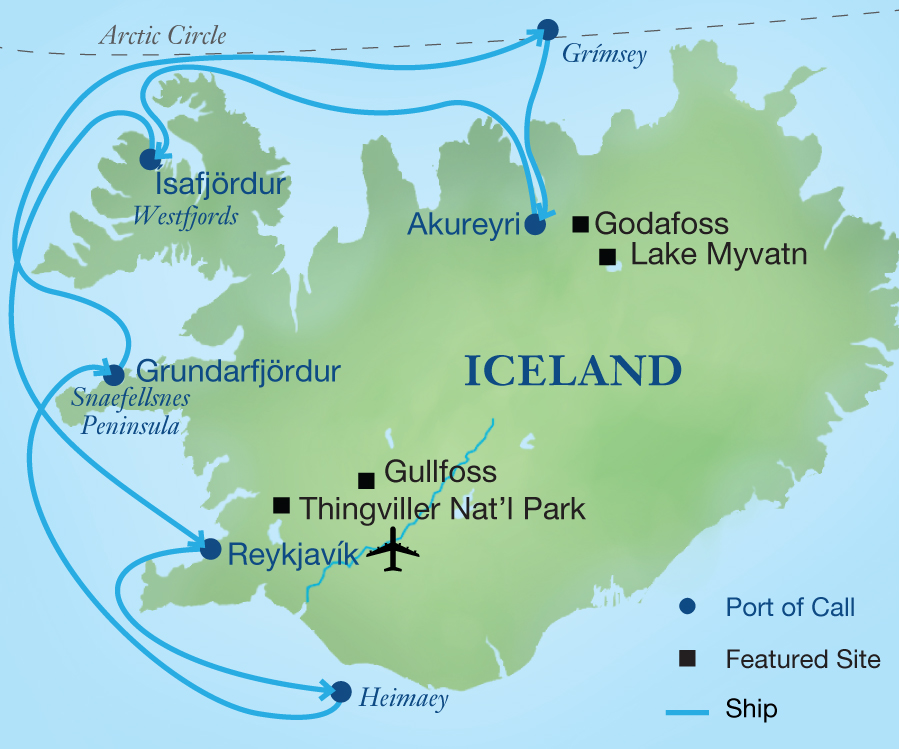
Encounter the thrilling geological extremes of Iceland, where glaciers and still-warm lava fields co-exist, and mystical emerald hills give way to bursting geysers and waterfalls. On a voyage that includes some of Iceland’s most remote corners, discover spectacular landscapes imbued with mythology, cross the Arctic Circle, and learn about the resilient people who have made their life in these rugged lands.
The Smithsonian Journeys / PONANT Experience: Each cruise will be accompanied by two Smithsonian Journeys Experts. An excursion or activity is included in each port of call. You may have a choice of excursions in many ports, so that you can delve more deeply into subjects that interest you.
Highlights Include
- Southern Islands: At Heimaey Island witness one of Iceland’s largest puffin colonies; see Mount Eldfell (the “Hill of Fire”), with its still-warm lava fields; and view Surtsey, the youngest island in the world.
- Snaefellsnes Peninsula: Arrive at the iconic cone-shaped peak of Kirkjufell and explore the many wonders of this mystical peninsula, from black-pebble beaches to legendary glaciers and charming villages set amid stunning lava landscapes.
- Grimsey: Spend an afternoon in the Arctic on Grimsey Island, a birdwatcher’s paradise that straddles the Arctic Circle. Enjoy the often-mild weather to watch for auks, puffins, and more.
- Lake Myvatn: Spend a day near cerulean Lake Myvatn, where volcanic activity—both past and current—is seen in a steaming geothermal field, unique craters, and surreal lava formations. Another highlight is legendary Godafoss, “waterfall of the gods.”
- Westfjords: Experience the beauty of this rugged region of mountains and fjords as you explore fishing villages and the town of Isafjördur. Learn about the area’s rich maritime history and fishing traditions at both the Heritage Museum and the tiny Osvör Maritime Museum.
- Golden Circle and Reykjavík: Encounter some of Iceland’s most iconic sites: Thingvellir, home of shifting tectonic plates and the world’s first legislative body; the two-tiered waterfall of Gullfoss; and the geothermal landscape of Geysir. Then take in panoramic views of Reykjavík from the viewing deck of the Pearl.
To see itinerary, please click on an option below.
2024 Itinerary
Day 1 — Reykjavík, Iceland
Arrive in Reykjavík, the world’s northernmost capital, inhabited by one half the country’s total population of 350,000. Board the ship late this afternoon and cruise towards the southern coast tonight. Take advantage of the summertime midnight sun to enjoy the scenery as we sail. (D)
Day 2 — Heimaey, Vestmannaeyjar
Sail to Iceland’s southern coast, arriving at Heimaey, the largest of the Westman Islands, at midday. Heimaey serves as a summer home to millions of seabirds—puffins, fulmars, guillemots, and others—whose eggs have traditionally been an important source of food for the islanders. Observe many of these birds nesting on the cliffs that surround the harbor. Then set off on your choice of two excursions. On a tour of this rugged outpost, pass through the Herjólfsdalur Valley, dotted with ruins of Viking farmhouses; and look out at the world’s youngest island, the World Heritage site of Surtsey, formed in a volcanic eruption in 1963. Stop at the puffin nesting ground of Stórhöfði and visit the fascinating Eldheimar Museum to see the excavated remains of a house buried by a massive volcanic eruption in 1973. (B,L,D)
Day 3 — Snaefellsnes Peninsula
The tiny village of Grundarfjördur is located at the foot of the Kirkjufell on the Snaefellsnes Peninsula. Arriving by boat means you’ll get a closer view of this cone-shaped lava-stone rock, which stands like a sentinel at the entrance to the bay. Spend the day discovering the many natural wonders of the peninsula, from the black-pebble beach of Djupalonssandur to the mystical glacier Snaefellnesjökull, made famous by French writer Jules Verne in his 1864 novel, A Journey to the Center of the Earth. Pass the cliffs of Londrangar the way to the fishing village of Arnarstapi, where we’ll take a walk to view splendid multicolor lava formations and abundant birdlife. Visit Budir, set among black lava fields at the edge of a long beach, before crossing the peninsula back to Grundarfjordur. Alternatively, enjoy a whale watching excursion in search of orcas, dolphins, and humpback, minke, sperm, and pilot whales. (B,L,D)
Day 4 — Grímsey
Grímsey is Iceland’s northernmost inhabited island, bisected by the Arctic Circle. From its only village, Grímseyjarhreppur, set out to explore its emerald hills, lushly carpeted with moss and grass. Despite its Arctic latitude, the weather on Grímsey is mild year round. You will see thriving populations of seabirds, especially auks. Their black and white coloring is similar to a penguin’s, but auks have the ability to fly above and dive into the Arctic waters. With luck, we’ll see puffins that come to nest on the island’s basalt cliffs from April to August. (B,L,D)
Day 5 — Akureyri and Lake Myvatn
Dock in Akureyri, Iceland’s second-largest town, and travel across the country’s extraordinary northern landscapes to Lake Mývatn, a haven for many rare migratory birds and 14 species of duck. Then experience some of the area’s fascinating geological phenomena, including the geothermal field of Namaskard, full of bubbling mud pots, steam vents, boiling springs, and fumaroles. Walk among the surreal lava formations of Dimmuborgir, the mythic source of Icelandic folklore. After lunch in Skútustaðir, explore the town’s distinctive pseudo-craters formed when hot lava flowed over the wetlands 2,300 years ago. On the way back to Akureyri, stop at Godafoss, the “waterfall of the gods.” According to legend, this spectacular waterfall earned its name when an Icelandic chieftain threw wooden statues of Norse gods into its crashing waters, signifying his conversion to Christianity. Alternatively, choose an excursion to the thermal baths at Húsavík that includes a stop at Godafoss. Relax in the mineral-rich waters of the GeoSea SeaBaths, taking in views of mountains, fjords, and sea. (B,L,D)
Day 6 — Isafjördur
Awaken in the stunning Westfjords region, a rugged peninsula that juts out of Iceland’s northwest coast. Drive along the coast to the tiny town of Bolungarvik, perched on a picturesque bay and bathed by the Isafjardardjup, the largest fjord on the Westfjords Peninsula. Visit the Osvör Maritime Museum, a cluster of old turf-and-stone fishing shacks restored in 1988. Here, examine everyday items that tell the story of the hardy community that eked out an existence catching and salting fish in this remote place. At the town’s Hólskirkja ("church on the hill"), see two grand bells meant to drive away the demons that live on the heath. Listen to traditional Icelandic folk songs performed by a local group of singers. On your return to Isafjördur, admire the 18th-century buildings of the old town, then tour the excellent Isafjördur Maritime Museum, a historic monument in itself, and enjoy a tasting of local specialties. Alternatively, ride a boat to the abandoned village of Hesteyri, a 19th-century whaling community located near the rugged landscapes of Hornstrandir Nature Reserve. Learn about the region’s unusual flora and fauna on a village tour, and stop at an inn for a traditional meal. (B,L,D)
Day 7 — Reykjavík
Return to Reykjavík this morning and set out to see the trio of scenic wonders known as the Golden Circle. Begin at the World Heritage site of Thingvellir National Park, a lava plain where the world’s oldest legislative body first convened in AD 930. Next, marvel at the “golden waterfall" of Gullfoss, where the river Hvita drops 96 feet in two stunning cascades. Continue to Geysir, a geothermal area that gave rise to the word “geyser.” Strokkur, the most active geyser here, erupts every few minutes. After lunch, make a stop in Hveragerdi, where geothermal energy has been used to power an extensive greenhouse industry. End the day back in Reykjavík, admiring sweeping views of the city from the viewing deck of the glass-domed Pearl. Alternatively, set off from Reykjavík’s harbor on a whale-watching cruise in search of humpback, minke and sei whales. (B,L,D)
Day 8 — Reykjavík /Return Home
After breakfast, disembark and transfer to the airport for your flight home. (B)
Included meals are denoted as follows: Breakfast (B), Lunch (L), Reception (R), Dinner (D)
2025 Itinerary
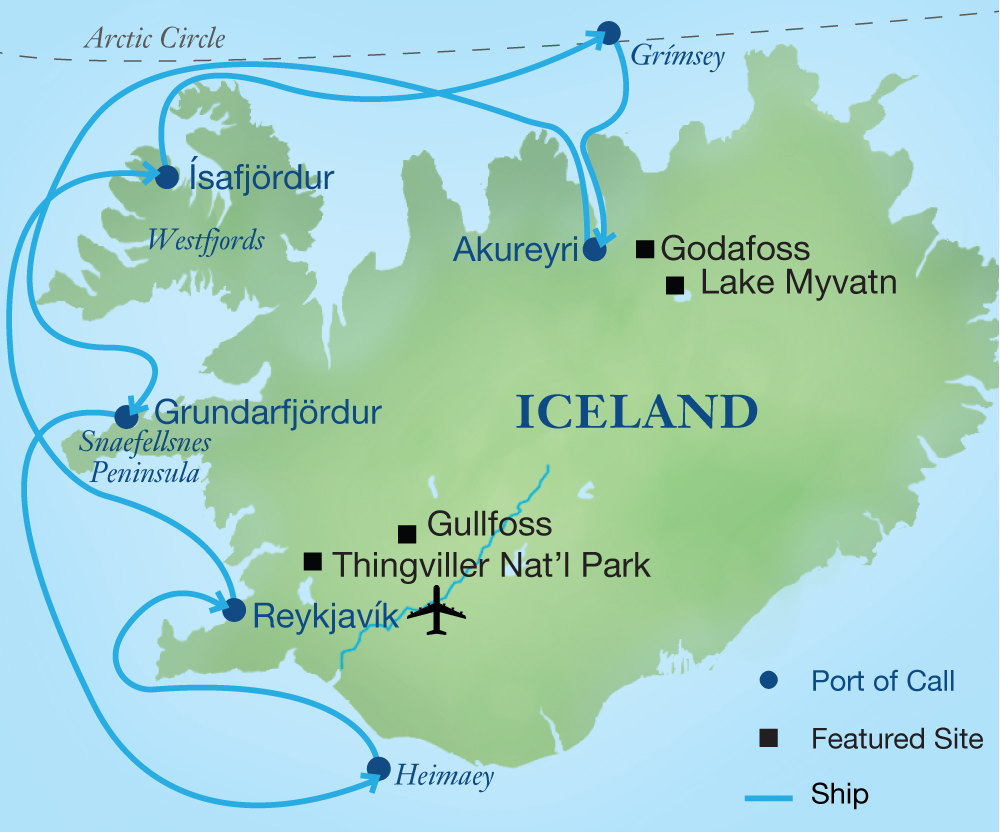
Day 1 — Reykjavík, Iceland
Arrive in Reykjavík, the world’s northernmost capital, inhabited by one half the country’s total population of 350,000. Board the ship late this afternoon and cruise towards the southern coast tonight. Take advantage of the summertime midnight sun to enjoy the scenery as we sail. (D)
Day 2 — Isafjördur
Awaken in the stunning Westfjords region, a rugged peninsula that juts out of Iceland’s northwest coast. Drive along the coast to the tiny town of Bolungarvik, perched on a picturesque bay and bathed by the Isafjardardjup, the largest fjord on the Westfjords Peninsula. Visit the Osvör Maritime Museum, a cluster of old turf-and-stone fishing shacks restored in 1988. Here, examine everyday items that tell the story of the hardy community that eked out an existence catching and salting fish in this remote place. At the town’s Hólskirkja ("church on the hill"), see two grand bells meant to drive away the demons that live on the heath. Listen to traditional Icelandic folk songs performed by a local group of singers. On your return to Isafjördur, admire the 18th-century buildings of the old town, then tour the excellent Isafjördur Maritime Museum, a historic monument in itself, and enjoy a tasting of local specialties. Alternatively, ride a boat to the abandoned village of Hesteyri, a 19th-century whaling community located near the rugged landscapes of Hornstrandir Nature Reserve. Learn about the region’s unusual flora and fauna on a village tour, and stop at an inn for a traditional meal. (B,L,D)
Day 3 — Grímsey
Grímsey is Iceland’s northernmost inhabited island, bisected by the Arctic Circle. From its only village, Grímseyjarhreppur, set out to explore its emerald hills, lushly carpeted with moss and grass. Despite its Arctic latitude, the weather on Grímsey is mild year round. You will see thriving populations of seabirds, especially auks. Their black and white coloring is similar to a penguin’s, but auks have the ability to fly above and dive into the Arctic waters. With luck, we’ll see puffins that come to nest on the island’s basalt cliffs from April to August. (B,L,D)
Day 4 — Akureyri and Lake Myvatn
Dock in Akureyri, Iceland’s second-largest town, and travel across the country’s extraordinary northern landscapes to Lake Mývatn, a haven for many rare migratory birds and 14 species of duck. Then experience some of the area’s fascinating geological phenomena, including the geothermal field of Namaskard, full of bubbling mud pots, steam vents, boiling springs, and fumaroles. Walk among the surreal lava formations of Dimmuborgir, the mythic source of Icelandic folklore. After lunch in Skútustaðir, explore the town’s distinctive pseudo-craters formed when hot lava flowed over the wetlands 2,300 years ago. On the way back to Akureyri, stop at Godafoss, the “waterfall of the gods.” According to legend, this spectacular waterfall earned its name when an Icelandic chieftain threw wooden statues of Norse gods into its crashing waters, signifying his conversion to Christianity. Alternatively, choose an excursion to the thermal baths at Húsavík that includes a stop at Godafoss. Relax in the mineral-rich waters of the GeoSea SeaBaths, taking in views of mountains, fjords, and sea. (B,L,D)
Day 5 — Snaefellsnes Peninsula
The tiny village of Grundarfjördur is located at the foot of the Kirkjufell on the Snaefellsnes Peninsula. Arriving by boat means you’ll get a closer view of this cone-shaped lava-stone rock, which stands like a sentinel at the entrance to the bay. Spend the day discovering the many natural wonders of the peninsula, from the black-pebble beach of Djupalonssandur to the mystical glacier Snaefellnesjökull, made famous by French writer Jules Verne in his 1864 novel, A Journey to the Center of the Earth. Pass the cliffs of Londrangar the way to the fishing village of Arnarstapi, where we’ll take a walk to view splendid multicolor lava formations and abundant birdlife. Visit Budir, set among black lava fields at the edge of a long beach, before crossing the peninsula back to Grundarfjordur. Alternatively, enjoy a whale watching excursion in search of orcas, dolphins, and humpback, minke, sperm, and pilot whales. (B,L,D)
Day 6 — Heimaey, Vestmannaeyjar
Sail to Iceland’s southern coast, arriving at Heimaey, the largest of the Westman Islands, at midday. Heimaey serves as a summer home to millions of seabirds—puffins, fulmars, guillemots, and others—whose eggs have traditionally been an important source of food for the islanders. Observe many of these birds nesting on the cliffs that surround the harbor. Then set off on your choice of two excursions. On a tour of this rugged outpost, pass through the Herjólfsdalur Valley, dotted with ruins of Viking farmhouses; and look out at the world’s youngest island, the World Heritage site of Surtsey, formed in a volcanic eruption in 1963. Stop at the puffin nesting ground of Stórhöfði and visit the fascinating Eldheimar Museum to see the excavated remains of a house buried by a massive volcanic eruption in 1973. (B,L,D)
Day 7 — Reykjavík
Return to Reykjavík this morning and set out to see the trio of scenic wonders known as the Golden Circle. Begin at the World Heritage site of Thingvellir National Park, a lava plain where the world’s oldest legislative body first convened in AD 930. Next, marvel at the “golden waterfall" of Gullfoss, where the river Hvita drops 96 feet in two stunning cascades. Continue to Geysir, a geothermal area that gave rise to the word “geyser.” Strokkur, the most active geyser here, erupts every few minutes. After lunch, make a stop in Hveragerdi, where geothermal energy has been used to power an extensive greenhouse industry. End the day back in Reykjavík, admiring sweeping views of the city from the viewing deck of the glass-domed Pearl. Alternatively, set off from Reykjavík’s harbor on a whale-watching cruise in search of humpback, minke and sei whales. (B,L,D)
Day 8 — Reykjavík /Return Home
After breakfast, disembark and transfer to the airport for your flight home. (B)
Included meals are denoted as follows: Breakfast (B), Lunch (L), Reception (R), Dinner (D)

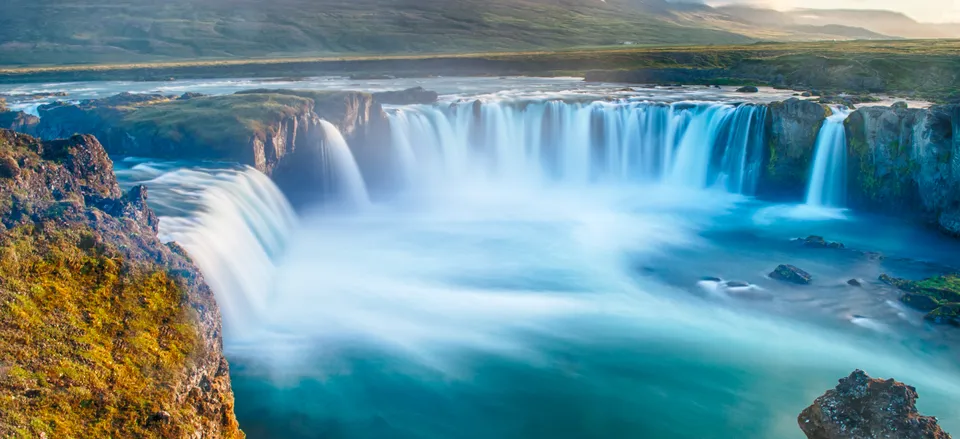
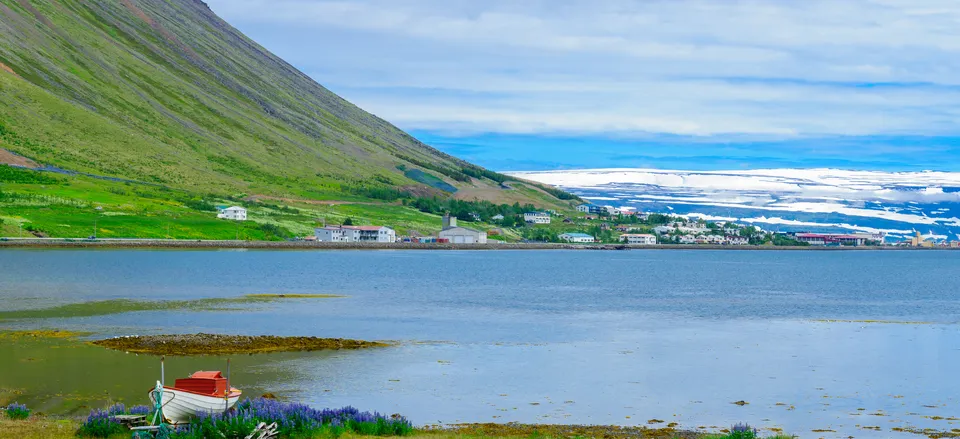
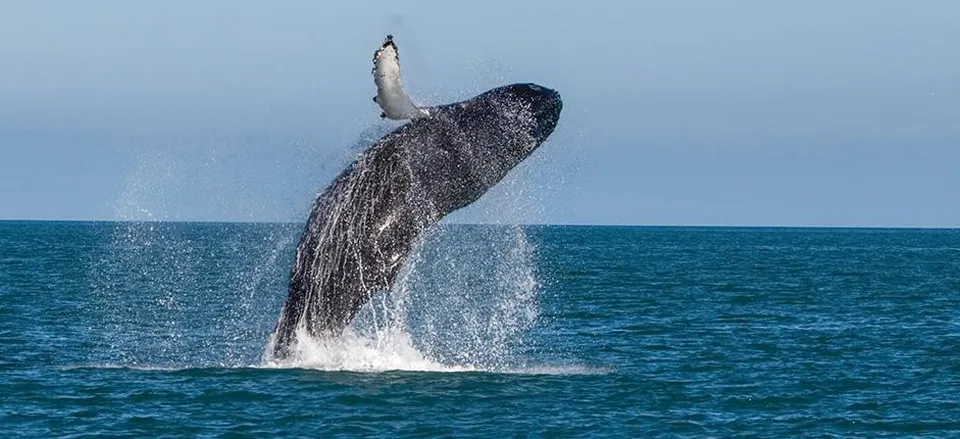
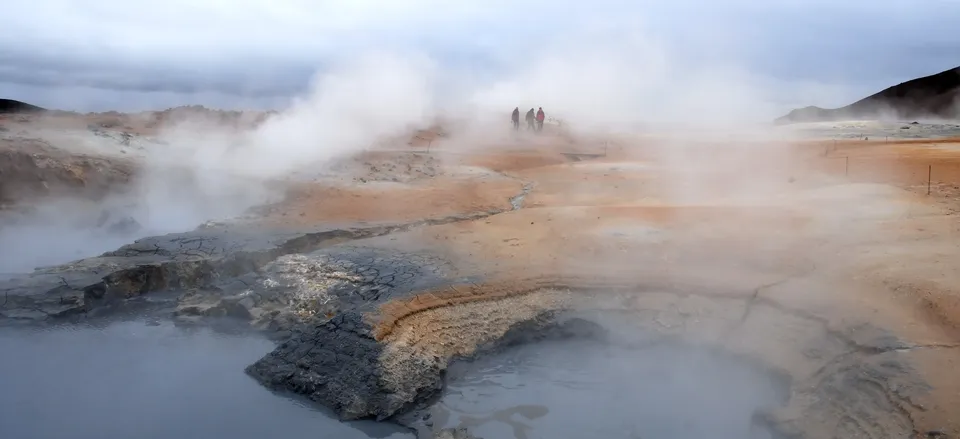
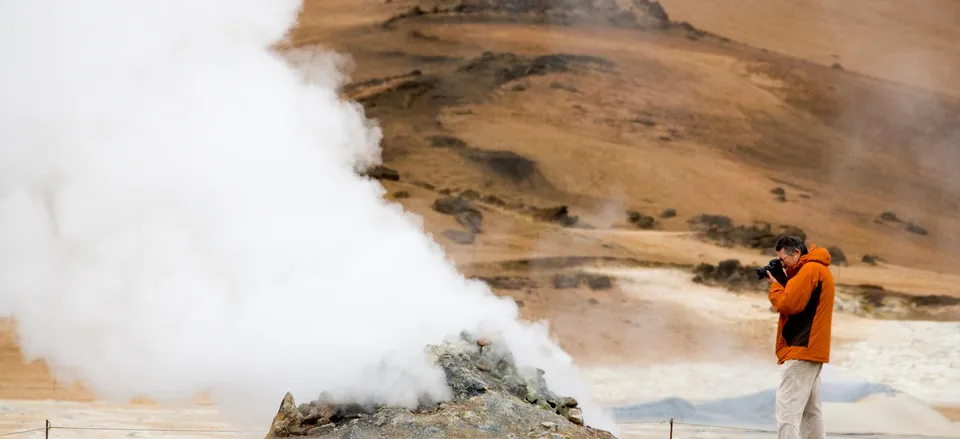
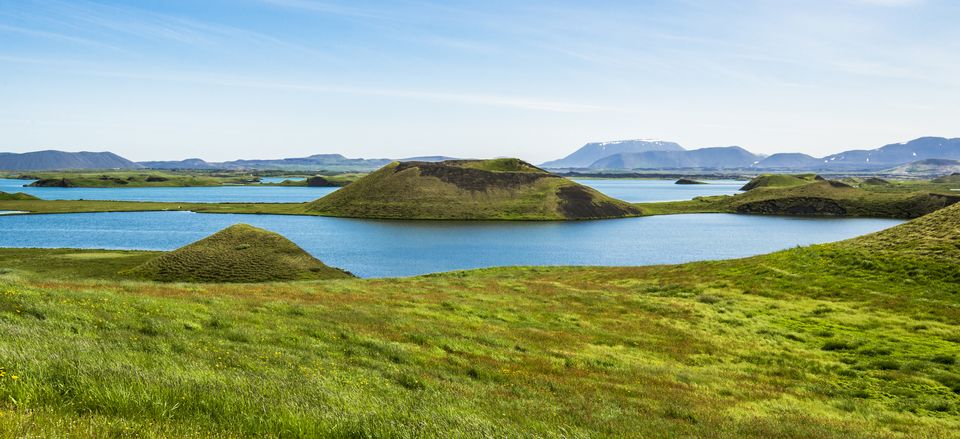
/https://tf-cmsv2-journeys-media.s3.amazonaws.com/filer/eb/e4/ebe45470-a331-43af-9ecf-906560905631/birds_ice_puffins_dt_xl_41700455.jpg)
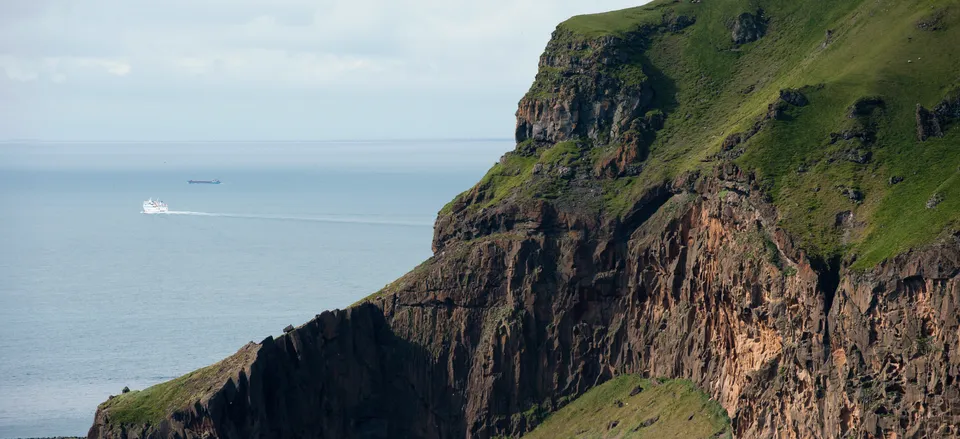
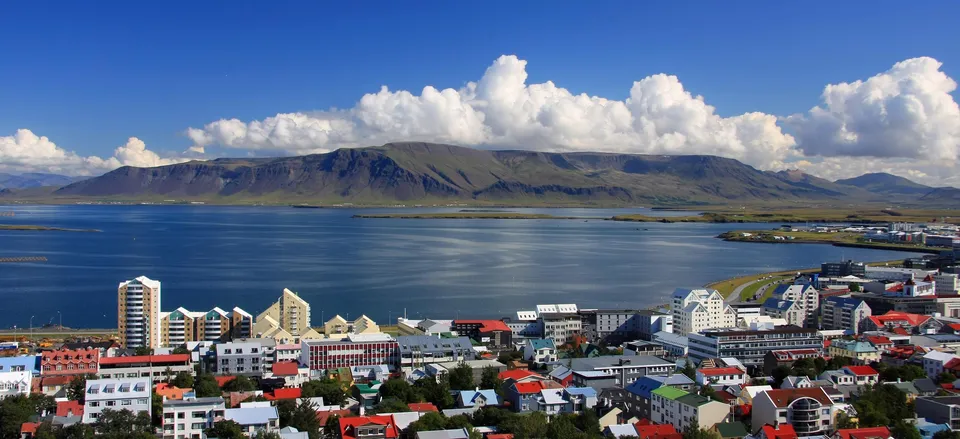
/https://tf-cmsv2-journeys-media.s3.amazonaws.com/filer/67/49/67490f74-a2b8-4c3f-b929-2a91c7f7099d/ice_glacier_seiceland_ist_1222043227.jpg)
:focal(1435x1105:1436x1106)/https://tf-cmsv2-journeys-media.s3.amazonaws.com/filer/88/1d/881d2aac-1de8-4878-90ae-b75a25604c87/family_ice_fathersonwaterfall_dt_xl_136797014_copy.jpg)
:focal(1738x1340:1739x1341)/https://tf-cmsv2-journeys-media.s3.amazonaws.com/filer/c0/31/c03130e2-f65f-49ff-900e-8fe871f6b5a9/ice_seljalandsfoss_dt_xl_35619700.jpg)
:focal(4500x2014:4501x2015)/https://tf-cmsv2-journeys-media.s3.amazonaws.com/filer_public/54/15/5415ee17-9b94-4c67-95f4-e134f3eeb5c8/ice_kirkjufellsfosswaterfall_ss_458404228.jpg)
:focal(821x711:822x712)/https://tf-cmsv2-journeys-media.s3.amazonaws.com/filer/80/1f/801f008f-78df-48fe-a33f-9e3db5b76eb6/can_vancouver_waterfront_dt_m_30494008.jpg)